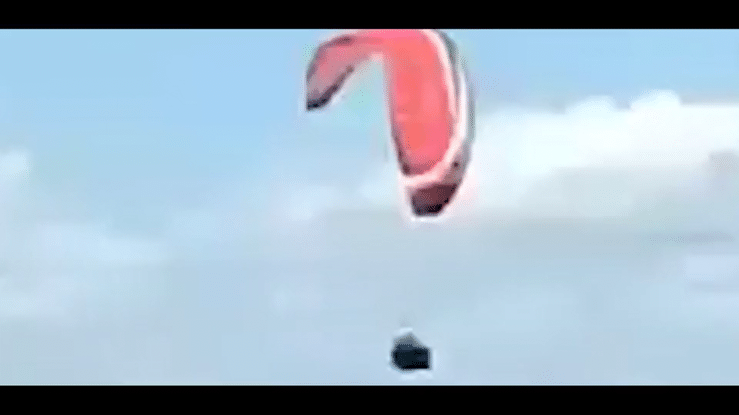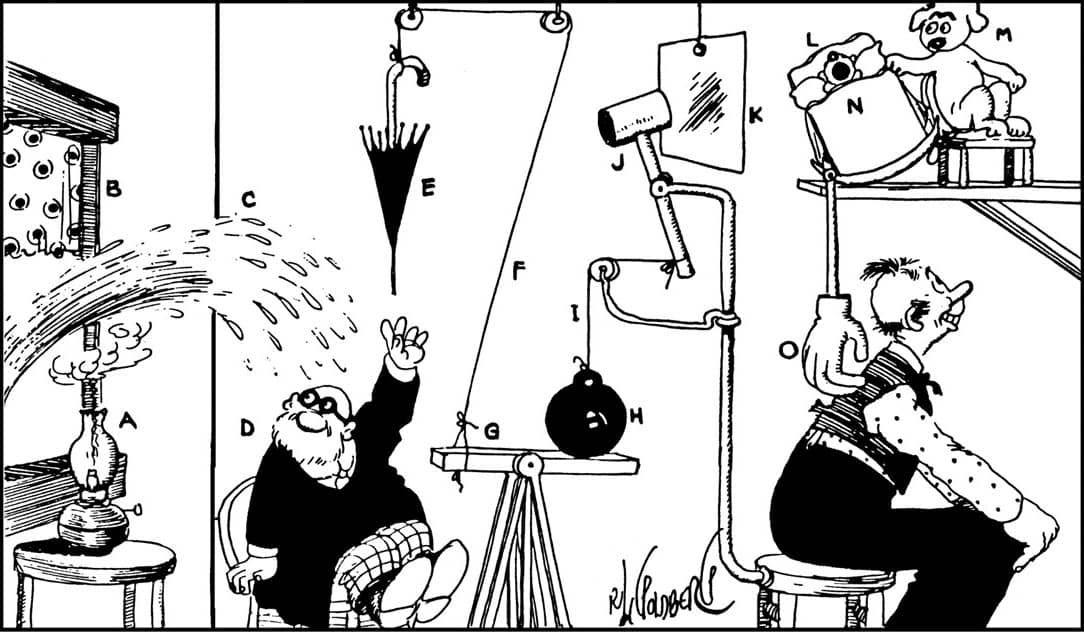It's impossible to die like this on a real aircraft
Paragliding fatality #2,150 meets Rube Goldberg
All you really need to know about paragliding is in this video
The last moments of the life of Alexandre Pereira Alves, paragliding fatality #2,150 by my incomplete tally, were captured on a cell phone last week as he fell through the Paragliding Dead Mans Curve (PDMC). In this forensic enhancement, I offer the supposed paragliding “experts” the opportunity to criticize Alex’s actions. Some of these people will claim that Alex caused this accident by doing this or that, by pulling down too hard on his brakes or by not throwing his reserve in time – and he deserved to die.
I, on the other hand, simply wish that Alex had been on a hang glider, instead. He would still be alive and enjoying free-flight because it is absolutely impossible to die like this on a real aircraft.
In the last moment before impact, Alex is in freefall and accelerating toward the ground at 9.81 m/s squared. He is not a pilot. He is nothing but a helpless human falling from the sky. He is fully decoupled from his control system and is falling in terror alongside the canopy, which arcs underneath him and he bizarrely slams to his death on top of it. The full video, including a slow motion sequence, is here.
In the short GIF sequence above, Alex is still connected by strings to the ridiculous mess that passes for a control system in paragliding. This Rube Goldberg contraption requires positive G to function. In zero or negative G, no control is possible. But despite having positive G just before he went weightless, I do not recognize even the slightest amount of control. This is the classic “loss of control” repeated by the press as they reported thousands of paragliding fatalities worldwide since 1986.
Paragliding enthusiasts often dismiss reports by journalists who have never flown paragliders as they attempt to explain what went wrong in the air just before a fatal accident, claiming the press does not have the experience to know what they are talking about. But I have over 3,000 miles of cross country experience on hang gliders, and I can’t tell what’s going on here, either. (And no, I’m not about to fly one to find out!) It looks to me that somebody sold Alex a bill of goods because that is obviously not an aircraft. It is a deathtrap.
A bill of goods, as a phrase, has two meanings. The less common is a delivery of goods, a consignment. The more common definition is something that is knowingly presented in a false way, usually with the intent to deceive or gain something by the trickery. — Grammarist



Posted to Kathrynsreport Aug 31 2022 http://www.kathrynsreport.com/2022/05/fatal-accident-occurred-may-13-2022-in.html?sc=1661967914527#c3216285610652030592
This time of year, it's difficult to keep up with the global fatalities occurring under paragliding canopies. Currently, Richard Willms of Wyoming was the 390th person to die on a powered paraglider by my very incomplete but verifiable count. That includes prop strikes while testing and a few bystanders who were in the way. Freeflight paragliding fatalities have reached an unacceptable and astounding 2,150 deaths since the first in 1986, including some rescuers and a few bystanders. Those who make direct comparisons to other forms of aviation tend to ignore the inherent characteristics of paragliders that make them deficient in terms of being real aircraft.
1) The operator is easily completely decoupled from control input through zero or negative G, twist, turbulence, collapse and cravat. The cravat [a suspension line crossed over a wingtip] often results in an unrecoverable nose-down spiral dive, a leading killer of paragliderists.
2) The paraglider operates within its own Dead Man's Curve where the reserve parachute will likely not deploy below 100 meters during take off, during landing and while ridge soaring.
3) The mass is concentrated essentially with the operator rather than the airfoil, resulting in zero kinetic energy outside the vertical vector for recovery.
4) Pitch and roll are severely limited and delayed.
5) In freeflight mountain launches the canopy is 20 feet above the backwards-facing operator and vulnerable to thermal activity. I have over 3000 miles of cross-country flying on hang gliders. I will not fly a paraglider because I cannot be confident that it will remain an aircraft from take off to landing. That is a reasonable concern for most of us. I consider those who choose to fly them among the greatest denialists in the history of aviation.
"Paragliding" seems to be attracting people because they call themselves pilots.
so called "Pilots" of a wing that stalls and collapses all the time, is not flying, it's the other ing word, "crashing", and the word aircraft does not apply.
Being able to "carve" a good turn is king, whether it's a hang glider or a surfboard or a skateboard or a pair of skis, something a parachute cannot do that has to "stall" a wing to turn.